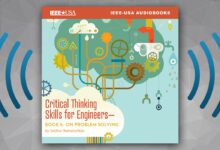
“The best and most lasting learning moments often come from parents,” says Harry T. Roman. “Learning is not something done just in school, or to leave to your children’s teachers.”
The veteran technology educator knows what he’s talking about. For many years, he has worked with schools throughout New Jersey to bring real-world problem-solving into the classroom. Now, he’s written an e-book that provides parents with dozens of practical ideas for helping their children to experience the power of solving problems, while also building logic and math skills.
Teaching Your Kids to Think and Solve Problems offers a practical approach. Using scenarios of typical activities around the home, Roman shows parents how they can encourage their children’s creative thinking. In concise, but information-packed chapters, the author describes how youngsters can help with such family-centered activities as home improvement projects, backyard improvements, kitchen skills and family vacations.
For example, the chapter on home improvement includes painting and wallpapering projects. When parents are planning to paint, just a few of Roman’s suggestions include: involving children in choosing colors, which includes teaching them about the color wheel and researching the internet for decorating ideas; teaching kids about paint through an outing to the local paint or home supplies store; and having them learn about the painting process by having them participate when the work starts.
“Hands are a tremendous tool for learning, since more than 50 percent of the brain’s frontal lobe capacity is dedicated to using the hands,” he writes. “In today’s schools, STEM education stresses the combined use of head-and-hands, because STEM is all about problem-solving.”
Wallpapering is another home improvement activity that parents can use to teach their children. Besides involving them in the aesthetic aspects of selecting wallpaper, the endeavor shows youngsters the importance of math in everyday life. That’s because they will need to determine how many rolls of wallpaper will be needed, as well as how much the entire project will cost.
In the chapter on backyard improvements, Roman offers dozens of ideas for engaging young minds with problem-solving projects. They range from activities like landscaping and gardening, to completely redesigning a backyard, and adding a swimming pool. For the family thinking about a complete redesign, he recommends planning sessions to determine how much space is available, areas that could be devoted to favorite family sports and other activities, and then developing a cost estimate. The Internet, as well as libraries, can be resources.
Is building and installing a pool on the horizon? The author provides a list of the many factors and issues that children can be involved with–and contribute to their problem-solving abilities. For example: whether the pool will be in-ground or above-ground; where the pump and accessories will be located; whether special permits will be needed from the city, even how a pool will affect parents’ homeowners insurance and taxes.
“I can see the kids making pictures, drawings, diagrams and sketches that portray ideas for all family members to look over and discuss,” says Roman. “A trip to a local pool company would also be a great way to get some ideas.”
He adds, “Help children visualize and understand how such projects have many components that must be considered. In this way, you teach them to break down large problems into more manageable smaller ones, so the whole project isn’t as daunting.”
Roman devotes a chapter to encouraging children to help plan family vacations. He recommends giving them a budget, and then letting them select the destination and hotel or living accommodations, how to get there, and things to do and see. Organization and planning skills are vital to a good vacation, so the various aspects of organizing something for the entire family can also help teach youngsters these abilities.
Kitchen activities also boost children’s creativity and problem-solving, according to the author. His suggestions range from teaching youngsters how to scale a recipe that will serve more people–to having them prepare appetizers from a group of foods set out for them to use.
Finally, in a valuable chapter on learning strategies, Roman points out what he believes parents should emphasize in encouraging children to think and solve problems, including:
- Encourage youngsters to ask questions, because inquiry can open the door to thinking creatively.
- Let children know that failure is okay, because it’s just another way of learning.
- Show children that real-world problems usually have multi-faceted solutions. These can range from economic and environmental impacts to legal concerns and regulatory compliance.
An IEEE Senior Member, Harry Roman has received many honors and recognitions from IEEE and other organizations for his contributions to technology education. Most recently, he was honored with the 2015 IEEE Region 1 Excellence in Teaching Award. Retired since 2006 from PSE&G, the largest utility company serving New Jersey, he has published more than 70 resource books, science kits and other educational products. He currently teaches graduate students at Montclair State University how to apply STEM techniques in the classroom.
Teaching Your Kids To Think and Solve Problems is available at https://ieeeusa.org/product/teaching-your-kids-to-think-and-solve-problems/. The book is $2.99 for IEEE members, and $4.99 for non-members.






